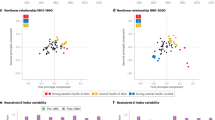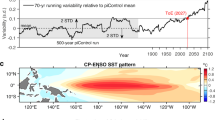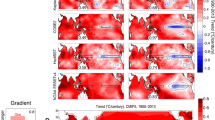Abstract
Future changes in the mean climate of the tropical Pacific and characteristics of the El Niño/Southern Oscillation (ENSO) are established as being likely. Determining the time of emergence of climate change signals from the natural variability is critical for mitigation strategies and adaptation planning. Here, using a multimodel ensemble, we find that the annual-mean sea surface temperature (SST) signal has already emerged across much of the tropical Pacific, appearing last in the east. The signal of a wetter annual-mean rainfall in the east is expected to emerge by mid-century, with some sensitivity to emission scenario. However, the ENSO-related rainfall variability signal is projected to emerge by about 2040 regardless of emission scenario, about 30 years earlier than ENSO-related SST variability signal at about 2070. Our results are instructive for the detection of climate change signals and reinforce the rapidly emerging risks of ENSO-induced climate extremes regardless of mitigation actions.
This is a preview of subscription content, access via your institution
Access options
Access Nature and 54 other Nature Portfolio journals
Get Nature+, our best-value online-access subscription
$29.99 / 30 days
cancel any time
Subscribe to this journal
Receive 12 print issues and online access
$209.00 per year
only $17.42 per issue
Buy this article
- Purchase on Springer Link
- Instant access to full article PDF
Prices may be subject to local taxes which are calculated during checkout





Similar content being viewed by others
Data availability
The CMIP6 model monthly outputs are archived at the Earth System Grid Federation server (https://esgf-node.llnl.gov/search/cmip6/). The HadISSTv1 dataset can be obtained from https://www.metoffice.gov.uk/hadobs/. The ERSSTv5 and COBEv2 datasets are both available from https://www.esrl.noaa.gov/psd/data/gridded/. All the outputs that support the findings of this study have been deposited in https://doi.org/10.5281/zenodo.588957564.
Code availability
All the codes are built on NCAR Command Language (NCL), available at https://doi.org/10.5281/zenodo.588576465.
References
Kosaka, Y. & Xie, S.-P. The tropical Pacific as a key pacemaker of the variable rates of global warming. Nat. Geosci. 9, 669–673 (2016).
Knutson, T. R. & Manabe, S. Time-mean response over the tropical Pacific to increased CO2 in a coupled ocean–atmosphere model. J. Clim. 8, 2181–2199 (1995).
Vecchi, G. A., Clement, A. & Soden, B. J. Examining the tropical Pacific’s response to global warming. Eos 89, 81–83 (2008).
Xie, S.-P. et al. Global warming pattern formation: sea surface temperature and rainfall. J. Clim. 23, 966–986 (2010).
Ying, J., Huang, P. & Huang, R. Evaluating the formation mechanisms of the equatorial Pacific SST warming pattern in CMIP5 models. Adv. Atmos. Sci. 33, 433–441 (2016).
Cai, W. et al. ENSO and greenhouse warming. Nat. Clim. Change 5, 849–859 (2015).
Deser, C., Phillips, A. S. & Alexander, M. A. Twentieth century tropical sea surface temperature trends revisited. Geophys. Res. Lett. 37, L10701 (2010).
Bordbar, M. H., Martin, T., Latif, M. & Park, W. Role of internal variability in recent decadal to multidecadal tropical Pacific climate changes. Geophys. Res. Lett. 44, 4246–4255 (2017).
Widlansky, M. J. et al. Changes in South Pacific rainfall bands in a warming climate. Nat. Clim. Change 3, 417–423 (2013).
Bayr, T., Dommenget, D., Martin, T. & Power, S. B. The eastward shift of the Walker circulation in response to global warming and its relationship to ENSO variability. Clim. Dynam. 43, 2747–2763 (2014).
Cai, W. et al. Increased variability of eastern Pacific El Niño under greenhouse warming. Nature 564, 201–206 (2018).
Ying, J., Huang, P., Lian, T. & Chen, D. Intermodel uncertainty in the change of ENSO’s amplitude under global warming: role of the response of atmospheric circulation to SST anomalies. J. Clim. 32, 369–383 (2019).
Cai, W. et al. Changing El Niño–Southern Oscillation in a warming climate. Nat. Rev. Earth Environ. 2, 628–644 (2021).
Cai, W. et al. in El Niño Southern Oscillation in a Changing Climate (eds McPhaden, M. J. et al.) 289–307 (AGU, 2020).
Huang, P. & Xie, S.-P. Mechanisms of change in ENSO-induced tropical Pacific rainfall variability in a warming climate. Nat. Geosci. 8, 922–926 (2015).
Callahan, C. W. et al. Robust decrease in El Niño/Southern Oscillation amplitude under long-term warming. Nat. Clim. Change 11, 752–757 (2021).
Wengel, C. et al. Future high-resolution El Niño/Southern Oscillation dynamics. Nat. Clim. Change 11, 758–765 (2021).
Philip, S. & van Oldenborgh, G. J. Shifts in ENSO coupling processes under global warming. Geophys. Res. Lett. 33, L11704 (2006).
Stevenson, S. L. Significant changes to ENSO strength and impacts in the twenty-first century: results from CMIP5. Geophys. Res. Lett. 39, L17703 (2012).
Watanabe, M. et al. Uncertainty in the ENSO amplitude change from the past to the future. Geophys. Res. Lett. 39, L20703 (2012).
Bellenger, H., Guilyardi, E., Leloup, J., Lengaigne, M. & Vialard, J. ENSO representation in climate models: from CMIP3 to CMIP5. Clim. Dynam. 42, 1999–2018 (2014).
Chen, C., Cane, M. A., Wittenberg, A. T. & Chen, D. ENSO in the CMIP5 simulations: life cycles, diversity, and responses to climate change. J. Clim. 30, 775–801 (2017).
Power, S., Delage, F., Chung, C., Kociuba, G. & Keay, K. Robust twenty-first-century projections of El Nino and related precipitation variability. Nature 502, 541–545 (2013).
Cai, W. et al. Increasing frequency of extreme El Nino events due to greenhouse warming. Nat. Clim. Change 4, 111–116 (2014).
Yun, K.-S. et al. Increasing ENSO–rainfall variability due to changes in future tropical temperature–rainfall relationship. Commun. Earth Environ. 2, 43 (2021).
Timmermann, A. Detecting the nonstationary response of ENSO to greenhouse warming. J. Atmos. Sci. 56, 2313–2325 (1999).
Latif, M. & Keenlyside, N. S. El Niño/Southern Oscillation response to global warming. Proc. Natl Acad. Sci. USA 106, 20578–20583 (2009).
DiNezio, P. N., Vecchi, G. A. & Clement, A. C. Detectability of changes in the Walker circulation in response to global warming. J. Clim. 26, 4038–4048 (2013).
Bellomo, K. & Clement, A. C. Evidence for weakening of the Walker circulation from cloud observations. Geophys. Res. Lett. 42, 7758–7766 (2015).
Chung, E. S. et al. Reconciling opposing Walker circulation trends in observations and model projections. Nat. Clim. Change 9, 405–412 (2019).
Hamlington, B. D. et al. Uncovering an anthropogenic sea-level rise signal in the Pacific Ocean. Nat. Clim. Change 4, 782–785 (2014).
Bordbar, M. H., Martin, T., Latif, M. & Park, W. Effects of long-term variability on projections of twenty-first century dynamic sea level. Nat. Clim. Change 5, 343–347 (2015).
Timmermann, A., McGregor, S. & Jin, F. F. Wind effects on past and future regional sea level trends in the Southern Indo-Pacific. J. Clim. 23, 4429–4437 (2010).
Eyring, V. et al. Overview of the Coupled Model Intercomparison Project Phase 6 (CMIP6) experimental design and organization. Geosci. Model Dev. 9, 1937–1958 (2016).
Heede, U. K. & Fedorov, A. V. Eastern equatorial Pacific warming delayed by aerosols and thermostat response to CO2 increase. Nat. Clim. Change 11, 696–703 (2021).
Vecchi, G. A. et al. Weakening of tropical Pacific atmospheric circulation due to anthropogenic forcing. Nature 441, 73–76 (2006).
Huang, P. Regional response of annual-mean tropical rainfall to global warming. Atmos. Sci. Lett. 15, 103–109 (2014).
McGregor, S. et al. Recent Walker circulation strengthening and Pacific cooling amplified by Atlantic warming. Nat. Clim. Change 4, 888–892 (2014).
Coats, S. & Karnauskas, K. B. Are simulated and observed twentieth century tropical Pacific sea surface temperature trends significant relative to internal variability? Geophys. Res. Lett. 44, 9928–9937 (2017).
Seager, R. et al. Strengthening tropical Pacific zonal sea surface temperature gradient consistent with rising greenhouse gases. Nat. Clim. Change 9, 517–522 (2019).
Watanabe, M., Dufresne, J.-L., Kosaka, Y., Mauritsen, T. & Tatebe, H. Enhanced warming constrained by past trends in equatorial Pacific sea surface temperature gradient. Nat. Clim. Change 11, 33–37 (2020).
Zhang, L. et al. Indian Ocean warming trend reduces Pacific warming response to anthropogenic greenhouse gases: an interbasin thermostat mechanism. Geophys. Res. Lett. 46, 10882–10890 (2019).
Wu, M. et al. A very likely weakening of Pacific Walker circulation in constrained near-future projections. Nat. Commun. 12, 6502 (2021).
Zhang, L. et al. Pacific warming pattern diversity modulated by Indo-Pacific sea surface temperature gradient. Geophys. Res. Lett. 48, e2021GL095516 (2021).
Liepert, B. G. & Previdi, M. Do models and observations disagree on the rainfall response to global warming? J. Clim. 22, 3156–3166 (2009).
Ropelewski, C. F. & Halpert, M. S. Global and regional scale precipitation patterns associated with the El Niño/Southern Oscillation. Mon. Weather Rev. 115, 1606–1626 (1987).
Deser, C. & Wallace, J. M. Large-scale atmospheric circulation features of warm and cold episodes in the tropical Pacific. J. Clim. 3, 1254–1281 (1990).
Ham, Y.-G. & Kug, J.-S. Improvement of ENSO simulation based on intermodel diversity. J. Clim. 28, 998–1015 (2015).
Jiang, W., Huang, P., Huang, G. & Ying, J. Origins of the excessive westward extension of ENSO SST simulated in CMIP5 and CMIP6 models. J. Clim. 34, 2839–2851 (2021).
Huang, P., Chen, D. & Ying, J. Weakening of the tropical atmospheric circulation response to local sea surface temperature anomalies under global warming. J. Clim. 30, 8149–8158 (2017).
Ying, J., Huang, P. & Lian, T. Changes in the sensitivity of tropical rainfall response to local sea surface temperature anomalies under global warming. Int. J. Climatol. 39, 5801–5814 (2019).
Beverley, J. D., Collins, M., Lambert, F. H. & Chadwick, R. Future changes to El Niño teleconnections over the North Pacific and North America. J. Clim. 34, 6191–6205 (2021).
England, M. H. et al. Recent intensification of wind-driven circulation in the Pacific and the ongoing warming hiatus. Nat. Clim. Change 4, 222–227 (2014).
Bordbar, M. H. et al. Uncertainty in near-term global surface warming linked to tropical Pacific climate variability. Nat. Commun. 10, 1990 (2019).
Rayner, N. A. et al. Global analyses of sea surface temperature, sea ice, and night marine air temperature since the late nineteenth century. J. Geophys. Res. 108, 4407 (2003).
Huang, B. et al. Extended reconstructed sea surface temperature, version 5 (ERSSTv5): upgrades, validations, and intercomparisons. J. Clim. 30, 8179–8205 (2017).
Hirahara, S., Ishii, M. & Fukuda, Y. Centennial-scale sea surface temperature analysis and its uncertainty. J. Clim. 27, 57–75 (2014).
Cai, W. et al. Butterfly effect and a self-modulating El Niño response to global warming. Nature 585, 68–73 (2020).
Hawkins, E. & Sutton, R. Time of emergence of climate signals. Geophys. Res. Lett. 39, L01702 (2012).
Johnson, N. C. & Xie, S.-P. Changes in the sea surface temperature threshold for tropical convection. Nat. Geosci. 3, 842–845 (2010).
Huang, P., Xie, S.-P., Hu, K., Huang, G. & Huang, R. Patterns of the seasonal response of tropical rainfall to global warming. Nat. Geosci. 6, 357–361 (2013).
Chou, C., Neelin, J. D., Chen, C.-A. & Tu, J.-Y. Evaluating the “rich-get-richer” mechanism in tropical precipitation change under global warming. J. Clim. 22, 1982–2005 (2009).
Ashok, K., Behera, S. K., Rao, S. A., Weng, H. & Yamagata, T. El Niño Modoki and its possible teleconnection. J. Geophys. Res. 112, C11007 (2007).
Ying, J. Datasets for emergence of climate change in the tropical Pacific. Zenodo https://doi.org/10.5281/zenodo.5889575 (2022).
Ying, J. Code for emergence of climate change in the tropical Pacific. Zenodo https://doi.org/10.5281/zenodo.5885764 (2022).
Acknowledgements
J.Y. was supported by the National Natural Science Foundation of China (grant numbers 41690121 and 41690120), the Scientific Research Fund of the Second Institute of Oceanography, Ministry of Natural Resources (grant number QNYC2001), the Innovation Group Project of the Southern Marine Science and Engineering Guangdong Laboratory (Zhuhai) (grant number 311021001) and the China Scholarship Council. M.C. was supported by a grant from the UK Natural Environment Research Council (NE/S004645/1). W.C. was supported by CSHOR, a joint research partnership between QNLM and CSIRO. A.T. and K.S. received funding from IBS under IBS-R028-D1. P.H. was supported by the National Natural Science Foundation of China (grant number 41975116) and the Youth Innovation Promotion Association of CAS (grant number 2016074). D.C. was supported by the National Natural Science Foundation of China (grant numbers 41690121 and 41690120).
Author information
Authors and Affiliations
Contributions
J.Y. and M.C. conceived the study. J.Y. performed the analyses and designed the methods. J.Y., M.C. and W.C wrote the manuscript. A.T., P.H., D.C. and K.S. contributed to improving the manuscript. All of the authors discussed the results and reviewed the manuscript.
Corresponding author
Ethics declarations
Competing interests
The authors declare no competing interests.
Peer review
Peer review information
Nature Climate Change thanks Mohammad Hadi Bordbar, Ulla Heede and the other, anonymous, reviewer(s) for their contribution to the peer review of this work.
Additional information
Publisher’s note Springer Nature remains neutral with regard to jurisdictional claims in published maps and institutional affiliations.
Extended data
Extended Data Fig. 1 Signal of EEP annual-mean SST and global-mean (60°S-60°N) SST change.
a, Signal of annual-mean SST in the EEP in MEM under historical and four future forcing scenarios and in observations. The shading denotes one intermodel standard deviation, with darker colours indicating higher emission scenarios; b and c, The same as a, but for global-mean SST change (b), and smoothed global-mean SST change by fitting a fourth-order polynomial (c).
Extended Data Fig. 2 Response of annual-mean SST to global warming.
a–c, Response of annual-mean SST to global warming for HadISSTv1, ERSSTv5 and COBEv2, respectively; d, MEM response of relative SST to global warming under historical and the SSP585 scenario; e–g, The same as a–c, but for relative SST. The green box in each plot denotes the eastern equatorial Pacific (2.5°S–2.5°N, 180°W–100°W). Stippling in a–c and e–g indicates that the regressions are significant above the 95% confidence level based on the Student’s t-test, while stippling in d denotes that more than 70% of models have the same sign.
Extended Data Fig. 3 EEP relative SST response to global warming calculated in increasing length of periods.
Shown is for response averaged over the EEP (2.5°S–2.5°N, 180°W–100°W) for 23 CMIP6 models under historical and the SSP585 scenario and in observations (y-axis, units: K K−1). The x-axis indicates the ending year of a period for calculation of the response, all starting from 1870; for example, when ending in 1949 (the first year shown), the response is calculated over the period from 1870–1949, and when ending in 2050 the response is calculated over the period from 1870–2050.
Extended Data Fig. 4 Intermodel relationship between dynamic rainfall response and annual-mean SST response.
a and b, Scatterplots of intermodel responses of dynamic rainfall with responses of relative SST (a) and tropical-mean SST (b) in the EEP under historical and the SSP585 scenario. The solid line in a denotes the linear regression. Digits on the upper-right corner of each plot are the intermodel correlations, with red (black) indicating statistically significant (insignificant) above the 95% confidence level based on a Student’s t-test. No regression line is plotted in (b) as the correlation is not significant.
Extended Data Fig. 5 Responses of ENSO SST and rainfall to global warming.
a–c, MEM Responses of ENSO SST under historical and the SSP126 (a), SSP245 (b), and SSP370 (c) scenarios. d–f, The same as a–c, but for HadISSTv1 (d), ERSSTv5 (e) and COBEv2 (f), respectively. Contours in d–f denote the respective ENSO SST pattern in the reference period (units: K, with an interval of 0.2 K, zero thickened and negative dashed). g–i, The same as a–c, but for ENSO rainfall. Stippling in a–c and g–i denotes that more than 70% of models have the same sign, while in d–f indicates that the regressions are significant above the 95% confidence level based on the Student’s t-test.
Extended Data Fig. 6 Signal of decomposed ENSO rainfall change and 30-year average relative SST change.
a, Signal of dynamic (red curve), thermodynamic (blue curve), and reconstructed (black curve) ENSO rainfall change in the EEP in MEM under historical and SSP585 scenario. The horizontal dashed lines denote the MEM threshold value for estimating the MEM detectable signal of dynamic (red), thermodynamic (blue), and reconstructed (black) ENSO rainfall. The vertical solid lines denote the ending year of a 30-year time window when the MEM signal of dynamic (red), thermodynamic (blue), and reconstructed (black) ENSO rainfall exceeds the defined threshold value. b, The same as Fig. 5b, but for the 30-year average relative SST change (see “Decomposition of 30-year average SST and ENSO rainfall change” in Methods).
Supplementary information
Supplementary Information
Supplementary Figs. 1–11 and Tables 1 and 2.
Rights and permissions
About this article
Cite this article
Ying, J., Collins, M., Cai, W. et al. Emergence of climate change in the tropical Pacific. Nat. Clim. Chang. 12, 356–364 (2022). https://doi.org/10.1038/s41558-022-01301-z
Received:
Accepted:
Published:
Issue Date:
DOI: https://doi.org/10.1038/s41558-022-01301-z
This article is cited by
-
Rising geopotential height under global warming
Climate Dynamics (2024)
-
Intermodel relation between present-day warm pool intensity and future precipitation changes
Climate Dynamics (2024)
-
Revisiting the equatorial Pacific sea surface temperature response to global warming
Climate Dynamics (2024)
-
Evaluation of CMIP6 model skills in simulating tropical climate extremes over Malawi, Southern Africa
Modeling Earth Systems and Environment (2024)
-
Anthropogenic impacts on twentieth-century ENSO variability changes
Nature Reviews Earth & Environment (2023)



